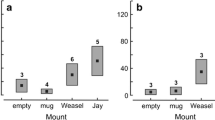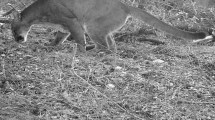Abstract
A free-ranging bushbuck (Tragelaphus scriptus) population was observed over a period of 3 years, thereby enabling long-term observations on object-horning behaviour (“horn-rubbing”, “ground-horning” and “horn-thrashing”) in male bushbuck. The primary aim of this study was to determine whether object-horning in male bushbuck serves as demarcation of a territory. Of the three male age classes investigated (territorial males, young-adult bachelors, sub-adult males) adult, territorial males tended to perform object-horning significantly more often than the members of the other two age classes. An analysis of whether territorial males performed object-horning more often in the presence of another individual, which would suggest that object-horning acts as a visual display, revealed that object-horning was predominantly performed when males were solitary. These results suggest that scent-marking and/or leaving visible traces on the vegetation or on the ground plays an important role in territory demarcation. No correlation was detected between food plant preferences and the frequency at which plant species were used for marking.



Similar content being viewed by others
References
Allsopp R (1978) Social biology of bushbuck (Tragelaphus scriptus Pallas, 1776) in the Nairobi National Park, Kenya. East Afr Wildl J 16:153–165
Apio A (2003) Foraging behaviour and gastro-intestinal tract parasitic infections of bushbuck (Tragelaphus scriptus Pallas, 1766) in Queen Elizabeth National Park, western Uganda. MSc thesis, University of Mbarara, Uganda
Apio A, Wronski T (2005) Foraging behaviour and diet composition of bushbuck (Tragelaphus scriptus Pallas, 1766) in Queen Elizabeth National Park, western Uganda. Afr J Ecol 43:225–232
Apio A, Plath M, Tiedemann R, Wronski T (2007) Age-dependent mating tactics in male bushbuck (Tragelaphus scriptus). Behaviour 144:585–610
Coppedge BR, Shaw JH (1997) Effects of horning and rubbing behavior by bison (Bison bison) on woody vegetation in a tallgrass prairie landscape. Am Midl Nat 138:189–196
Dunham KM (1982) The foraging behaviour of impala (Aepyceros melampus). S Afr J Wildl Res 12:36–40
East R (1999) African antelope data base 1998. IUCN/SSC Antelope Specialist Group. IUCN Publ, Cambridge
Estes RD (1991) The behavior guide to African mammals. University of California Press, Berkeley
Ewer RF (1976) Ethologie der Säugetiere. Parey, Berlin, Hamburg
Geist V (1964) The rutting behaviour of the mountain goat. J Mammal 45:551–568
Gilbert BK (1973) Scent marking and territoriality in pronghorn (Antilope cervicapra) in Yellowstone National Park. Mammalia 37:25–33
Gosling LM (1982) A reassessment of the function of scent marking in territories. Z Tierpsychol 60:89–118
Gosling LM (1985) The even-toed ungulates: order Artiodactyla. Sources, behavioural context, and function of chemical signals. In: Brown RE, MacDonald DW (eds) Social odours in mammals, vol. 2. Clarendon Press, Oxford, pp 550–618
Gosling LM (1990) Scent marking by resource holder: alternative mechanisms for advertising the costs of competition. In: MacDonald D, Müller-Scharze D, Natynczuk SE (eds) Chemical signals in vertebrates, vol. 5. University Press, Oxford, pp 315–328
Gosling LM, Roberts SC (2001) Scent-marking by male mammals: cheat-proof signals to competitors and mates. Adv Stud Behav 30:169–217
Graf W (1956) Territorialism in deer. J Mammal 37:165–170
Hillman JC (1974) Ecology and behavior of the wild eland. Wildlife News 9:6–9
Hillman JC (1979) The biology of the eland (Taurotragus oryx Pallas) in the wild. PhD thesis, University of Nairobi, Nairobi, Kenya
Jacobsen NHG (1974) Distribution, home range and behaviour patterns of bushbuck in the Lutope and Sengwa Valleys, Rhodesia. J South Afr Wildl Assoc 4:75–93
Jarman MV (1973) The quintessential antelope. Afr Wildl Leader Found Newsl 8:3–7
Johansson A, Liberg O (1996) Functional aspects of marking behaviour by male roe deer (Capreolus capreolus). J Mammal 77:558–567
Kingdon J (1982) East African mammals. Volume 3C, Bovids. The University of Chicago Press, Chicago
Kitchener AC (1987) Fracture toughness of horns and a reinterpretation of the horning behavior of bovids. J Zool 213:621–639
Leuthold W (1977) African ungulates, a comparative review of their ethology and behavioural ecology. Springer, Berlin
Lock JM (1977) The vegetation of the Rwenzori National Park, Uganda. Bot Jahrb Syst 98:372–148
Macleod SB, Kerley GIH, Gayland A (1996) Habitat and diet of bushbuck Tragelaphus scriptus in the woody Cape Nature Reserve: observations from faecal analysis. S Afr J Wildl Res 26:19–25
Martin P, Bateson P (1985) Measuring behaviour: an introductory guide. Cambridge University Press, Cambridge
Odendaal PB, Bigalke RC (1979) Home range and groupings of bushbuck in the southern Cape. S Afr J Wildl Res 9:39–41
Owen-Smith N (1979) Assessing the foraging efficiency of a large herbivore, the kudu. S Afr J Wildl Res 9:102–110
Roberts SC (1997) Selection of scent-marking sites by klippspringers (Oreotragus oreotragus). J Zool 243:555–564
Simpson CD (1972) Some characteristics of tragelaphine horn growth and their relationship to age in greater kudu and bushbuck. J S Afr Wildl Manage Assoc 2:1–8
Simpson CD (1973) Tooth replacement, growth and ageing criteria for the Zambezi bushbuck-Tragelaphus scriptus ornatus Pocock. Arnoldia 6:1–25
Simpson CD (1974) Habitat reference and seasonal movement in the Chobe bushbuck, Tragelaphus scriptus ornatus Pocock, 1900. Arnoldia 31:1–7
Smits CMM (1986) Diet composition and habitat use of the West African bushbuck Tragelaphus scriptus scriptus (Pallas, 1776) during the first half of the dry season. S Afr J Zool 21:89–94
Toweill DE, Thomas JW, McCabe RE (2002) North American elk: ecology and management. Smithsonian Books, Washington D.C.
Verheyen R (1955) Contribution a l’etude ethologique du waterbuck (Kobus defassa ugandae) et de l’antelope harnachée (Tragelaphus scriptus). Mammalia 19:309–319
Walther FR (1964) Verhaltensstudien an der Gattung Tragelaphus de Blainville (1816) in Gefangenschaft, unter besonderer Berücksichtigung des Sozialverhaltens. Z Tierpsychol 21:393–476
Walther FR (1966) Mit Horn und Huf. Parey, Hamburg, Berlin
Walther FR (1974) Some reflexions on expressive behaviour in combats and courtship of certain horned ungulates. In: Geist V, Walther FR (eds) The behaviour of ungulates and its relation to management. IUCN publications No. 24(2), pp 56–106
Walther FR (1977) Quantitative and functional variations of certain behaviour patterns in male Thomson’s gazelle of different social status. Behaviour 65:212–240
Walther FR (1978) Forms of aggression in Thomson’s Gazelle; their situated motivation and their relative frequency in different sex, age, and social classes. Z Tierpsychol 47:113–172
Waser PM (1975) Spatial association and social interactions in a “solitary ungulate”: the bushbuck Tragelaphus scriptus (Pallas). Z Tierpsychol 37:24–36
Wronski T (2005) Home range overlap and spatial organisation as indicators for territoriality among male bushbuck (Tragelaphus scriptus). J Zool 266:1–9
Wronski T, Apio A (2006) Home range overlap, social vicinity and agonistic interactions denoting matrilineal organisation in bushbuck, Tragelaphus scriptus. Behav Ecol Sociobiol 59:810–828
Wronski T, Plath M (2006) Mate availability and intruder pressure as determinants of territory size in male bushbuck (Tragelaphus scriptus). Acta Ethol 9:37–42
Wronski T, Apio A, Baranga J, Plath M (2006a) Scent marking, agonistic interactions and territorial defense in male bushbuck (Tragelaphus scriptus). J Zool 270:49–57
Wronski T, Apio A, Plath M (2006b) The communicatory significance of localised defecation sites in bushbuck (Tragelaphus scriptus). Behav Ecol Sociobiol 60:368–378
Wronski T, Apio A, Wanker R, Plath M (2006c) Behavioural repertoire of the bushbuck (Tragelaphus scriptus): Agonistic interactions, mating behaviour and parent-offspring relations. J Ethol 24:247–260
Wronski T, Tiedemann R, Apio A, Plath M (2006d) Cover, food, competitors and individual densities within bushbuck (Tragelaphus scriptus) female clan home ranges. Acta Theriol 51:319–326
Acknowledgements
We would like to thank the Research Division of the Uganda Wildlife Authority, and the Uganda National Council for Science and Technology for the permission to conduct this research in Queen Elizabeth National Park. This study was generously supported by a scholarship from the German Academic Exchange Service (DAAD). We are greatly indebted to Hans Klingel, University of Braunschweig, Germany, to Harald Schliemann and Jakob Parzefall, both of the University of Hamburg, Germany and to Jonathan Baranga, Mbarara University of Science and Technology, Uganda for their continuous support to our project. Ludwig Siefert, Makerere University, Uganda kindly assisted with technical and veterinary support in the field. Solomon Kyabulima and the late Marcello Onen helped with food plant identification and the collection of a considerable amount of data. Kathreen Ruckstuhl and an anonymous reviewer provided very helpful comments.
Author information
Authors and Affiliations
Corresponding author
Electronic supplementary material
Below is the link to the electronic supplementary material.
About this article
Cite this article
Wronski, T., Kabasa, J.D., Plath, M. et al. Object-horning as advertising and marking behaviour in male bushbuck (Tragelaphus scriptus)?. J Ethol 26, 165–173 (2008). https://doi.org/10.1007/s10164-007-0048-x
Received:
Accepted:
Published:
Issue Date:
DOI: https://doi.org/10.1007/s10164-007-0048-x




